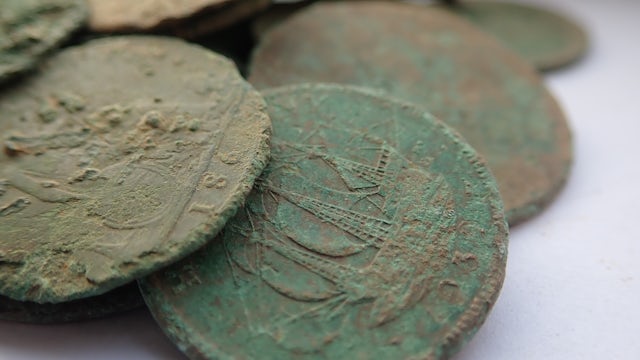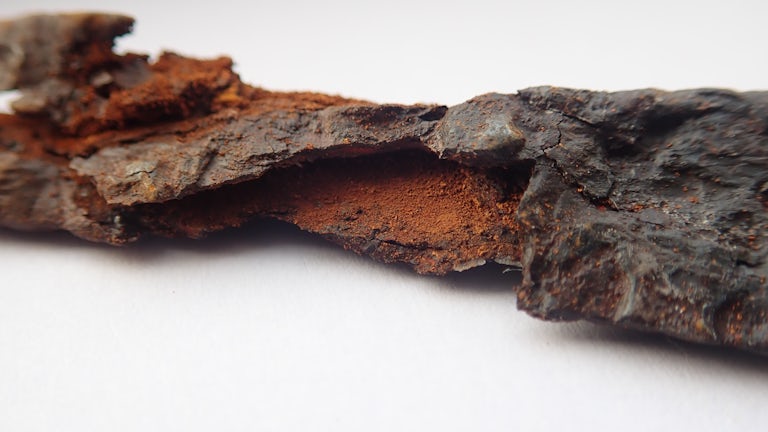
Saving metal heritage for future generations
Our research has guided the decisions saving our metal heritage, from archaeological repositories – containing millions of artefacts charting human history – to iconic ships, including the Mary Rose, Brunel’s SS Great Britain, and the Spanish Armada.
As trained conservators, Professor Dave Watkinson and Dr Nicola Emmerson have experienced first-hand, the effects of corrosion on metal artefacts, and the many challenges related to their preservation and storage.
Thanks to their research, they have now provided much needed evidence-based guidance to help organisations to conserve their artefacts, helping them to make better use of their resources and plan for the future.
Professor Watkinson explains, “I have always had an interest in metals. Having researched iron conservation as a student, it seemed natural to continue work in an area where there are so many unanswered questions in conservation.
“As a practical conservator, you are always looking for answers and guidance. When I started out, conservators were often reliant on anecdotal evidence which wasn’t particularly robust. With colleagues in the sector, we have developed a research culture that did not really exist in conservation previously.”
Dr Emmerson brought a new angle to the research when she joined the team, with her investigation of coatings – used to protect iron elements – in outdoor architecture and our most iconic historic bridges.
Corrosion
Archaeological metal artefacts containing chlorides can corrode rapidly while in storage, or on display, leading to complete loss of collections. There was limited evidence of the effectiveness of existing corrosion prevention methods – such as aqueous washing to remove chlorides and creating low-humidity environments around artefacts – for preserving archaeological metal collections.
Professor Watkinson and Dr Emmerson are experts in assessing corrosion rates and risk for archaeological metals, particularly iron and copper alloy. The research team initially proved a threshold of 12% relative humidity (RH) below which no corrosion occurs. Further work established a scale of risk to metal artefacts, according to humidity and chloride, and examined the methods used to mitigate the risk.
“We examined how fast objects deteriorate at different humidities, to establish how you can control corrosion by reducing humidity, and investigated the effectiveness of the methods used to do that. This allowed us to recommend procedures for controlling deterioration of objects by desiccation and offer options for accepting very slow corrosion at low risk to objects, where the cost or practicality of creating extremely dry environments is not feasible,” Professor Watkinson explains.
As a result of the research, the sector now has a scale for acceleration of chloride-driven corrosion with increasing humidity, and an expectation of the nature and extent of the damage that it will cause.
The guidelines in practice
As a result of the work by Professor Watkinson, Dr Emmerson, and their colleagues, museums and heritage organisations across the world are using the guidelines to help them preserve and store their collections for generations to come.
These guidelines are:
- Recommended as best practice for desiccated storage of metals in the Society of Museum Archaeology Standards in the Care of Archaeological Collections (April 2020). The Society stated that the research “enhanced the quality of our Guidance” ensuring that museum professionals understand “how to make the decisions that will determine the longevity and condition of the collections in their care.”
- Embedded in the forthcoming edition of ‘First Aid for Finds’ the key manual for archaeological excavations used across the world. The new edition includes our guidelines on post-excavation management of archaeological metals.
- The basis of new training materials for the Portable Antiquities Scheme, and also underpinned training for archaeologists by staff from the National Museum of Ireland and the National Trust.
In the USA, 65% of heritage organisations holding historic artefacts report damage following improper storage. The team provided bespoke Desiccated Storage Guidance (May 2020) for the American Institute for Conservation Storage Techniques for Art, Science and History Collections. This is helping to extend the lifetimes of millions of artefacts deemed ‘at risk’.
The researchers produced a treatment and display plan, based on their research for recently discovered relics of sixteenth century warfare. This included eight bronze cannon and an iron-shod carriage wheel raised from the 1588 Spanish Armada wreck, La Juliana. The artefacts are displayed at National Museum of Ireland, in controlled conditions, without fear of damage or disfigurement from corrosion.
Storage and display of collections
Professor Watkinson and Dr Emmerson knew that there was an urgent need in the sector to look at low humidity storage of artefacts in plastic boxes, a common and affordable approach to preservation in museums and archives. The team offered a bespoke service, looking at the objects that the museums were trying to preserve. They investigated how the low-humidity storage principles could be applied to individual items, or entire collections, in the operating context of each institution.
The team investigated variables in storage procedures and produced evidence-based guidelines for the museum and the wider sector. These include recommendations for the most airtight storage boxes, the optimum amount of silica gel to dry the air in the boxes, and the required frequency of changing silica gel – with all outcomes linked to humidity-related risk to objects.
“We worked with the Museum of London, who have hundreds of thousands of iron objects in store, all in storage boxes, and with limited numbers of staff to deal with them. From our research, we can demonstrate how choosing the right design of box and optimising the amount of silica gel in each one means the air inside will stay drier for longer, reducing the frequency of regenerating the gel to save staff time,” Professor Watkinson says.
The Museum of London used the research to perform risk assessments of its storage options, modify its silica gel replacement schedule, and establish regular, long-term monitoring of storage boxes. This led to decreased likelihood of corrosion, as well as reduced staff costs for management of the storage boxes, as less time is spent regenerating and changing the silica gel.
Humidity control for objects on display is more complex. Dedicated showcases for metal artefacts can be conditioned by silica gel or mechanical plant. But, where mixed materials are displayed together, the low humidity essential for survival of metals could damage organic objects.
Dehumidification is possible on a much larger scale, covering whole rooms and display spaces, but this is costly. The team calculated the risk of raising acceptable humidity values, to allow organic and metal artefacts to be displayed together at the Mary Rose Museum. The corrosion risk scale was also made available to the SS Great Britain Trust, to support their economic management of the large-scale desiccation plant, controlling the dry dock housing Brunel’s iron ship.
Dr Emmerson explains, “We know how dry the environment needs to be to stop corrosion, but we appreciate that might not be achievable for every institution. With this data, we can allow some amount of flexibility, knowing that corrosion will be quite slow. It is the same principle with the boxes. We know organisations can only put so much resource into managing this problem, but this work has shown that they do have a bit of flexibility and that the risks are quite low as long as they follow certain procedures.”
Continuous improvement
Their work continues as Dr Emmerson explains, “Conservation often borrows from other sectors, for example, the storage boxes we use are largely manufactured for the food industry. When new designs of box are developed, we need to test them for their suitability for use in the heritage sector. Even within the same storage range the manufacturers will change aspects of material and design for a box and, suddenly, something that has been recommended for 20 years no longer performs in the same way.”
Professor Watkinson adds, “For any of the research that we get involved in, our focus is on what advice and guidelines it will produce for best practice in the sector. Over the years, we then work on how these can be refined and improved by further scientific research, and its application in practice. Our research does not finish with solving the scientific question, we are always thinking about implementing the results and how these can be improved upon.”


Research in archaeology
We are making archaeology relevant to today’s great environmental and societal challenges, delivering projects that address heritage preservation, climate change and social inequalities.
Meet the team
Key contacts
Publications
- Emmerson, N. , Thunberg, J. and Watkinson, D. 2020. New guidelines for the desiccated storage of archaeological metal artefacts. Presented at: 48th AIC/SPNHC Joint Virtual Annual Meeting 2020 Virtual 21 May - 230 June 2021.
- Watkinson, D. E. , Rimmer, M. B. and Emmerson, N. J. 2019. The Influence of relative humidity and intrinsic chloride on post-excavation corrosion rates of archaeological wrought iron. Studies in Conservation 64 (8), pp.456-471. (10.1080/00393630.2018.1565006)
- Watkinson, D. E. and Emmerson, N. J. 2017. The impact of aqueous washing on the ability of βFeOOH to corrode iron. Environmental Science and Pollution Research 24 , pp.2138-2149. (10.1007/s11356-016-6749-3)
- Watkinson, D. et al. 2013. The use of neutron analysis techniques for detecting the concentration and distribution of chloride ions in archaeological iron. Archaeometry n/a (10.1111/arcm.12058)






